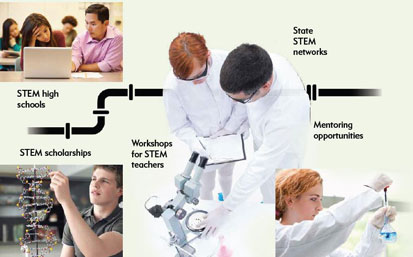As any good engineer can tell you, a pipeline is only as sound as its component parts. If it has bottlenecks or leaky joints, it can’t perform at anything close to top capacity. So it is with STEM. Whether or not there is a STEM crunch—too few science and technology students graduating from Ninth District colleges and universities to meet employer demand—educators, state officials and many employers say that not enough science or technology students are making it all the way through the pipeline from elementary school to the workplace.
The K-12 learning environment is widely seen as a major contributor to the problem. Many middle and high school students do poorly in science and advanced math, or avoid those subjects because they’re considered boring or too difficult. (In Minnesota, 2015’s graduating high school class will be the first required to complete a chemistry or physics course.)
There’s evidence to support the idea that potential STEM workers are falling by the wayside in the education system. Nationally, less than 40 percent of college freshmen who declare their intention to major in a STEM field end up getting a STEM degree, according to the President’s Council of Advisors on Science and Technology.
And U.S. high school students post lower math and science scores on international tests than peers in many other developed countries. It may not be a coincidence that students from high-scoring countries such as Canada, Korea and China account for a rising share of the graduating classes of STEM degree programs in the district. (For more about international college students in the district, see “Flying colors.”)
But earnest efforts are afoot across the Ninth District to increase the flow of homegrown STEM graduates into the workforce.
Get your geek on
The past five years have seen a groundswell of initiatives in the district intended to encourage more students to pursue STEM degrees and to improve science and technology teaching at all levels of education.
Several district states have developed STEM networks, broad-based programs designed to engage a wide variety of stakeholders in the STEM effort. The Twin Cities-based Minnesota STEM Network describes itself as “a community of practice” for STEM education and workforce development that includes schools, government agencies, businesses and community groups. An outgrowth of SciMathMn, a nonprofit focused on STEM education from prekindergarten through college, the organization seeks to raise public awareness of STEM, promote effective STEM teaching and boost the number of students pursuing STEM careers.
A $300,000 appropriation by the 2013 North Dakota Legislature established that state’s STEM Network. Executive Director David DeMuth Jr., a physics professor at Valley City State University, says the nascent network will foster a teaching and learning philosophy—based on the engineering design process—in which students work cooperatively in teams to solve problems. Five regional STEM networks are planned in the state, including one representing Indian tribes.
STEM schools represent another broad approach to getting students involved in science and technology. Public schools in every district state—among them Richfield STEM School in Minnesota and Fond du Lac STEM Institute in Wisconsin—have embraced the STEM designation, although STEM schools are not certified as such by any official body. Some simply beef up offerings and requirements in science, math and related subjects, while others emphasize novel approaches such as interdisciplinary and project-based learning.
A variation on STEM schools—and the latest buzzword in K-12 education—is the STEAM school. Since 2010, a number of middle and high schools in district states have adopted curricula that blend math, science and the arts.
Other STEM initiatives in the district focus on discrete student populations or fields of study within STEM. A program developed last year at South Dakota State University (SDSU) aims to improve STEM education in the state, emphasizing rural areas where one instructor may be called upon to teach several science and technology subjects. The Institute for STEM Education Enhancement supports workshops for science and math teachers, and administers federal grants for college juniors and seniors pursuing secondary school teaching certificates in math and science.
“The goal is to ... encourage more students to go into STEM education,” said Institute Director Sharon Vestal, who teaches math education at SDSU. “We all know that’s a necessary part of the big STEM picture, because we can’t recruit students if we don’t have awesome teachers out there.”
Racial minorities earn science and engineering degrees at less than half the rate of whites, according to the National Science Foundation. In Minnesota, the goal of the NorthStar STEM Alliance is to double every five years the number of minority students at 14 higher education institutions in the state receiving STEM bachelor’s degrees. NorthStar, funded by the National Science Foundation, tutors college students and provides mentoring, internship and undergraduate research opportunities. Alliance members include the University of Minnesota, Carleton College, the Science Museum of Minnesota and the Minnesota High Tech Association (MHTA).
The future of industry
Efforts to promote STEM education include direct intervention in the career-building process by employers, who have a vested interest. The more young people who study science and technology in secondary school and go on to earn STEM degrees, the larger the pool of potential STEM recruits.
In Montana, over 1,000 high school students take part in a privately funded program that awards $10,000 in prizes for learning computer programming online. Computer science is not part of the core curriculum in Montana public schools (or in most school districts across the country). “Introducing computer science in K through 12 allows students to apply math in a way that makes their core studies more interesting,” said Greg Gianforte, a Bozeman tech entrepreneur who co-founded CodeMontana last fall and has covered most of its startup costs.
Gianforte said that one of the program’s goals is “to raise awareness that there are careers for people who work with computers in Montana,” so that high school students will be motivated to study computer science in college—and stick around to take jobs in burgeoning technology hubs such as Bozeman.
Scholarships are another example of private sector efforts to increase the number of STEM graduates entering the workforce. For the past several years, the MHTA Foundation has awarded more than $70,000 annually in scholarships to Minnesota undergraduates pursuing degrees in STEM or STEM teaching. Awards can include internships at MHTA member companies.
And Land O’Lakes, the giant dairy cooperative, offers $5,000 annual scholarships to juniors and seniors studying food, agriculture and natural resource sciences at the University of Minnesota. “Our goal with the scholarship program is to support students who want a career in agriculture, and STEM fits right into that,” said Lydia Botham, director of the Land O’Lakes Foundation. “Science and technology are key components to the work we do at Land O’Lakes, and these students are the future of our industry.”
Related content
Getting to the root of STEM
Colleges and universities in the district are producing more science and technology graduates. But job opportunity for those workers varies by occupation and geography, and demand for STEM skills is likely to grow






